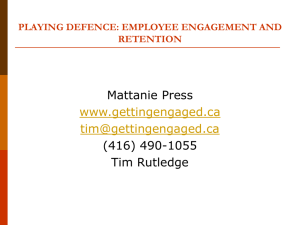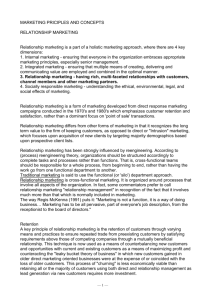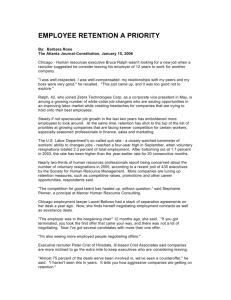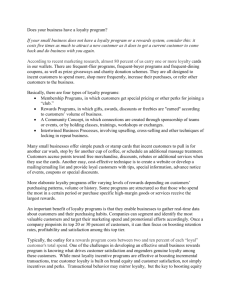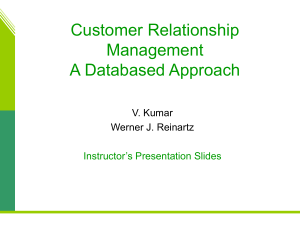rutledge
advertisement
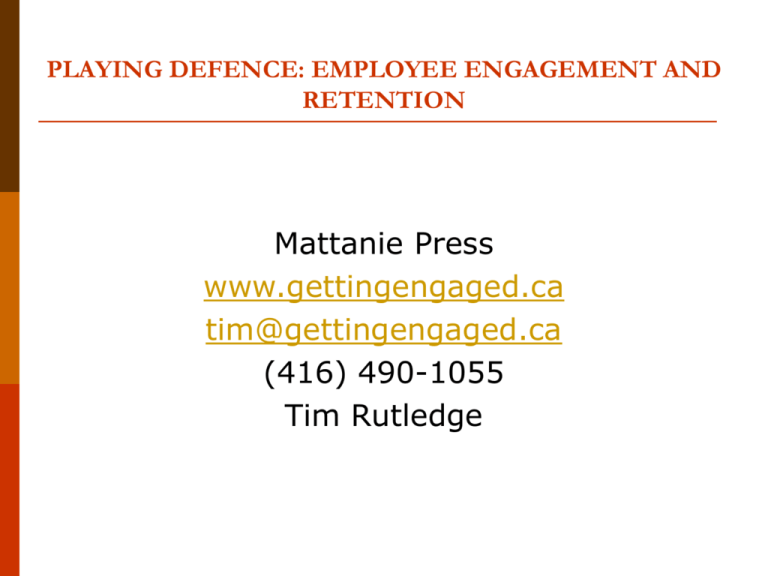
PLAYING DEFENCE: EMPLOYEE ENGAGEMENT AND RETENTION Mattanie Press www.gettingengaged.ca tim@gettingengaged.ca (416) 490-1055 Tim Rutledge Agenda The coming supply/demand shift From loyalty to engagement From replacement to retention Role of the manager in retention Elements of engagement The coming supply/demand shift Statistics/demographics Shift to a sellers’ market “Employees who leave can always be replaced” Employees are customers, not commodities Bye, Bye, Boomers Past 5 years 225,000 retirements in Canada Next 5 years 320,000 (StatsCan) Early in 2005 Generation X and Y workers became the majority in the workplace. Boomers no longer dominant. (Rainmaker Thinking) “Even if Canada brings in 500,000 immigrants every year, it won’t be enough to solve the worker shortfall.” (Hon. Joe Fontana, Minister of Labour, October 2004) There could be a worker shortfall of 1 million jobs by 2020 (Conference Board of Canada) Paradigm Shift Old paradigm (buyer’s market): “Employees who leave can always be replaced” New paradigm (seller’s market): “I must identify my key employees and work to keep them from leaving, because I may not be able to replace them with comparable talent” FROM BUYER’S TO SELLER’S JOB MARKET Buyer’s Market Seller’s Market Loyalty Marriage – long term Dating – Engagement – short term Employees Costs, commodities Investments, consumers Supervisory skills Optional Essential Hiring occurs when . . . Positions become vacant Talent becomes available Fair treatment Treating all employees the same Treating talent differently Poor performers Tolerated Managed out Performance ratings Tend towards sameness Rigourously differentiated Supervisory focus Rescuing marginal performers Developing talent Organizational rewards Distributed somewhat evenly Distributed to talent From loyalty to engagement Engagement: the state of being attracted, committed, and fascinated Engaging Employment Experiences Short-term orientation What is Disengagement? Passive Disengagement: going through the motions retired but forgot to leave Active Disengagement speaking negatively about the organization sniping from the sidelines What Causes Disengagement? Lack of recognition for achievements Feeling that no one will listen to you Wondering who would miss you if you didn’t show up Having work that isn’t challenging, or even interesting You’re not learning anything new You feel alone, performing heroic deeds all by yourself, and no one notices What about Money? Effects of more money (and other tangible rewards) exhilarating at the time but they don’t last Money can retain but it can’t engage From replacement to retention The differentiated workforce The retention-eligible employee Who is retention-eligible? Cost of replacement 3 strategies: recruit, replace, retain Which is the most cost-effective? Who is a Key Employee? ANY EMPLOYEE YOU ARE NOT WILLING TO FACE THE FUTURE WITHOUT Top Notch Tricia High potential Exceeds most objectives Favourably known to senior management Eager to take on more work, and a greater variety of work Expresses interest in other departments Solid Steve High performer Is in the exact right job Competition would love to have him Has realized his potential, and it’s very good Average Amy Performance is satisfactory Sometimes needs to be chased to get work done, but otherwise fine Needs no particular improvement Nothing distinguishing about performance Iffy Ivan Performance below standard Manager believes it can improve Unsatisfactory Ursula Performance below standard Manager believes it will stay that way Has realized her potential, and it’s not good enough Retention – Eligible? Top Notch Tricia Solid Steve Average Amy Iffy Ivan Unsatisfactory Ursula Costs of Replacement 150% of salary Example: Company A replaces 8 employees (average salary $90,000) 8 x $90,000 x 150% = $1,080,000 Company B replaces 4 employees 4 x $90,000 x 150% = $540,000 Role of the manager in retention “The most important factor in employees’ willingness to engage is their feeling about their relationship with their supervisors” “You can’t afford to have poor managers” Getting Engaged: The New Workplace Loyalty Survivalists Success = nothing bad happened today Workplace a dangerous place Risk avoiders (as opposed to risk managers) Employees are naughty children Hostile to change Value rules and regulations, policies and procedures, forms and signatures Low expectations of performance Taskoholics Employees are cogs in a machine, replaceable parts Manager’s role is to program employees Always busy, but not with managing Low expectations of performance Value large quantities of work Focused on outputs and results, not on people Command and Control Need You To Need Me Value employee happiness Feel responsible for employee happiness Low expectations of performance Uncomfortable with happy, productive employees “Parenting managers” Surround themselves with performance problems Integrals Passionate about organization’s work and employee contributions to it Champions of change when it’s needed to reach organizational goals High expectations of performance Drive Survivalists nuts Leaders Elements of Engagement Communicate the Big Picture Implement Flexible Work Arrangements Promote Individual Learning Differentiate Performances Recognize Achievements Coach Listen Banish “Command and Control” Communicate the Big Picture Mission: why the organization exists Vision: a big, audacious goal Values: what the organization cherishes Competencies: behavioural expressions of values Implement Flexible Work Arrangements Schedule overtime in advance Encourage working from home where possible Make some jobs part-time Institute the compressed work week Have volunteer days Install a core work day e.g. 10:00 a.m. 3:00 p.m. Extend 3 day weekends to 4 Promote Individual Learning Personal Development Plans Treat training as a planned absence from work Mentoring Showcases and Displays Customer contact Skunk works Differentiate Performances Have the courage to rate different performances differently Unfairness and subjectivity Failure of nerve Rewards aren’t worth it Non-performance criteria Recognize achievements Rewards vs. recognition Rewards: given by the organization, governed by formal policies Recognition: given by manager, informal Listening Turning off the power Coaching An “uncovery” process Banish Command and Control Need to be arbitrary Value loyalty and obedience (will protect poor performers who are obedient and loyal) Project an air of infallibility Make all decisions in unit Must be obeyed MATTANIE PRESS www.gettingengaged.ca tim@gettingengaged.ca (416) 490-1055
